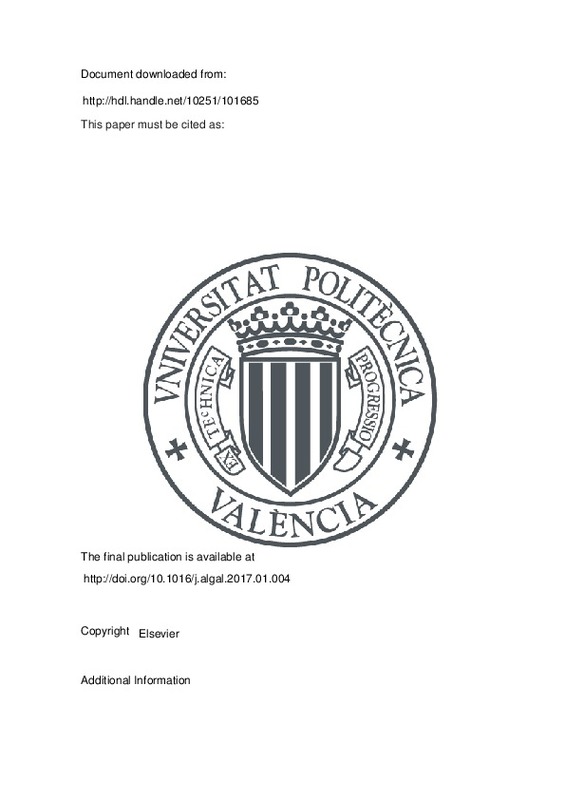JavaScript is disabled for your browser. Some features of this site may not work without it.
Buscar en RiuNet
Listar
Mi cuenta
Estadísticas
Ayuda RiuNet
Admin. UPV
Light distribution and spectral composition within cultures of micro-algae: Quantitative modelling of the light field in photobioreactors
Mostrar el registro sencillo del ítem
Ficheros en el ítem
| dc.contributor.author | Fuente-Herraiz, David
|
es_ES |
| dc.contributor.author | Keller, Joseph
|
es_ES |
| dc.contributor.author | Conejero, J. Alberto
|
es_ES |
| dc.contributor.author | Roegner, Matthias
|
es_ES |
| dc.contributor.author | Rexroth, Sascha
|
es_ES |
| dc.contributor.author | Urchueguía Schölzel, Javier Fermín
|
es_ES |
| dc.date.accessioned | 2018-05-10T09:04:38Z | |
| dc.date.available | 2018-05-10T09:04:38Z | |
| dc.date.issued | 2017 | es_ES |
| dc.identifier.uri | http://hdl.handle.net/10251/101685 | |
| dc.description.abstract | [EN] Light, being the fundamental energy source to sustain life on Earth, is the external factor with the strongest impact on photosynthetic microorganisms. Moreover, when considering biotechnological applications such as the production of energy carriers and commodities in photobioreactors, light supply within the reactor volume is one of the main limiting factors for an efficient system. Thus, the prediction of light availability and its spectral distribution is of fundamental importance for the productivity of photo-biological processes. The light field model here presented is able to predict the intensity and spectral distribution of light throughout the reactor volume. The input data for the algorithm are chlorophyll-specific absorption and scattering spectra at different irradiance values for a given organism, the depth of the photobioreactor, the cell-density and also the intensity and emission spectrum of the light source. Although in the form exposed here the model is optimized for photosynthetic microorganism cultures inside flat-type photobioreactors, the theoretical framework is easily extensible to other geometries. Our calculation scheme has been applied to model the light field inside Synechocystis sp. PCC 6803 wild-type and Olive antenna mutant cultures at different cell-density concentrations exposed to LED lamps of different colours, delivering results with reasonable accuracy, despite the data uncertainties. To achieve this, Synechocystis experimental attenuation profiles for different light sources were estimated by means of the Beer- Lambert law, whereby the corresponding downward irradiance attenuation coefficients were obtained through inherent optical properties at any wavelength within the photosynthetically active radiation band. In summary, the model is a general tool to predict light availability inside photosynthetic microorganism cultures and to optimize light supply, in respect to both intensity and spectral distribution, in technological applications. This knowledge is crucial for industrialscale optimisation of light distribution within photobioreactors and a fundamental parameter for unravelling the nature of many photosynthetic processes. | es_ES |
| dc.description.sponsorship | This project has received funding from the European Union's Seventh Programme for Research, Technological Development and Demonstration under grant agreement No 308518 CyanoFactory, to Javier Urchueguia's and Matthias Rogner's respective research groups and from the grant Contratos Predoctorales FPI 2013 of the Universitat Politecnica de Valencia to the first one. We would also like to thank David Lea-Smith and Dariusz Stramski for their fruitful and selfless contribution. We kindly acknowledge the experimental support of Saori Fuse for the cultivation of cyanobacteria. | en_EN |
| dc.language | Inglés | es_ES |
| dc.publisher | Elsevier | es_ES |
| dc.relation.ispartof | Algal Research | es_ES |
| dc.rights | Reserva de todos los derechos | es_ES |
| dc.subject | Absorption | es_ES |
| dc.subject | Scatering | es_ES |
| dc.subject | Attenuation | es_ES |
| dc.subject | Inherent optical properties | es_ES |
| dc.subject | Modelling | es_ES |
| dc.subject | Synechocystis | es_ES |
| dc.subject.classification | MATEMATICA APLICADA | es_ES |
| dc.subject.classification | FISICA APLICADA | es_ES |
| dc.title | Light distribution and spectral composition within cultures of micro-algae: Quantitative modelling of the light field in photobioreactors | es_ES |
| dc.type | Artículo | es_ES |
| dc.identifier.doi | 10.1016/j.algal.2017.01.004 | es_ES |
| dc.relation.projectID | info:eu-repo/grantAgreement/EC/FP7/308518/EU/Design, construction and demonstration of solar biofuel production using novel (photo)synthetic cell factories/ | |
| dc.rights.accessRights | Abierto | es_ES |
| dc.date.embargoEndDate | 2019-05-01 | es_ES |
| dc.contributor.affiliation | Universitat Politècnica de València. Departamento de Física Aplicada - Departament de Física Aplicada | es_ES |
| dc.contributor.affiliation | Universitat Politècnica de València. Departamento de Matemática Aplicada - Departament de Matemàtica Aplicada | es_ES |
| dc.description.bibliographicCitation | Fuente-Herraiz, D.; Keller, J.; Conejero, JA.; Roegner, M.; Rexroth, S.; Urchueguía Schölzel, JF. (2017). Light distribution and spectral composition within cultures of micro-algae: Quantitative modelling of the light field in photobioreactors. Algal Research. 23:166-177. https://doi.org/10.1016/j.algal.2017.01.004 | es_ES |
| dc.description.accrualMethod | S | es_ES |
| dc.relation.publisherversion | http://doi.org/10.1016/j.algal.2017.01.004 | es_ES |
| dc.description.upvformatpinicio | 166 | es_ES |
| dc.description.upvformatpfin | 177 | es_ES |
| dc.type.version | info:eu-repo/semantics/publishedVersion | es_ES |
| dc.description.volume | 23 | es_ES |
| dc.identifier.eissn | 2211-9264 | es_ES |
| dc.relation.pasarela | S\327722 | es_ES |
| dc.contributor.funder | European Commission | es_ES |
| dc.contributor.funder | Universitat Politècnica de València |







![[Cerrado]](/themes/UPV/images/candado.png)

